After recovering from the back injury that sidelined me from my second half marathon, I took an extended break from racing. I didn’t run another half for a couple of years after 2004, but instead, I set my sights on something bigger: my first full marathon.
The Decision to Go All In
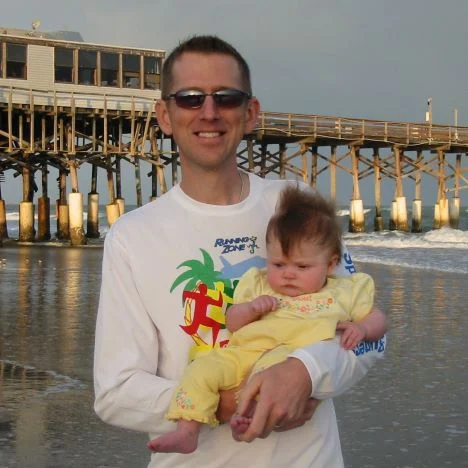
The year was 2006. My kids were five years old, three years old, and a newborn. My youngest daughter had just been born in July, and right around that time, something got into my head—I was going to run my first marathon.
Now, any reasonable person might have looked at my life circumstances and thought, This is not the ideal time to start training for 26.2 miles. My wife, Lynn, was already handling a newborn and two small kids, and here I was committing to a training plan that would take up hours of my weekends. But in my head, I justified it. I’ll be running early in the morning, before anyone gets up. It won’t impact the family much.
Of course, as I’ve been reminded (many times) over the years, the reality was a little different. While I was out logging long runs, the house was very much awake, and Lynn could have used the extra set of hands. I have some regrets about that now, but I also deeply appreciate the support she gave me as I trained.
My motivation? The marathon had always felt like the holy grail of running. I’d conquered the half, my back was healed, and I wanted to take on the next challenge.
Training for My First Marathon
I followed a 16-week training plan I pulled from Runner’s World’s old Smart Coach feature. You’d input your race goal, recent times, and preferred difficulty level, and it would spit out a custom plan. I set an ambitious goal: 3 hours and 30 minutes—an 8:00 per mile pace.
At that point, my only half marathon had been in 2004, where I finished in 1:41 (a 7:45 pace). Given my layoff and the realities of the marathon distance, I expected to be a little slower, but I was still determined to aim high.
One thing I’ve learned after multiple marathons: a good predictor of marathon performance is taking your half marathon time, doubling it, and adding 20 minutes. If I had known that then, I might have set a more realistic goal closer to 3:45, but at the time, I went with my gut.
Training took place in the brutal heat of a Chicago summer. I got some natural heat acclimation, which—ironically—would come in handy later. My plan followed the tried-and-true 80/20 principle: 80% easy running, 20% harder efforts. My long runs increased gradually, peaking at 20 miles, and I mixed in speed work at the track: 400m repeats, then 800m repeats.
One of the most beneficial aspects of my plan was incorporating marathon pace miles into long runs. Early in training, I’d run something like 12 miles, with 2 at marathon pace. By the time I hit my 20-miler, the breakdown was:
- 5 miles easy (9:00-9:30 pace)
- 10 miles at marathon pace (8:00)
- 5 miles easy to finish
This combination of speed work + marathon pace long runs turned out to be the key to race day success.
A Memorable (and Questionable) Long Run

One long run stands out. We took a weekend trip to Galena, Illinois, a picturesque town with antique shops and rolling hills. One morning, I headed out early for my scheduled run. Downtown Galena was eerily quiet, a stark contrast to its usual bustling crowds.
But as I ran out of town, I found myself on a winding two-lane road, no sidewalks, barely any shoulder, and semi-trucks roaring past me. Several times, I had to jump into the ditch to avoid getting clipped. In hindsight, it was incredibly reckless. I’m lucky nothing happened. Looking back, I should’ve mapped out a safer route—or just hit the treadmill.
Race Week and Pre-Marathon Jitters
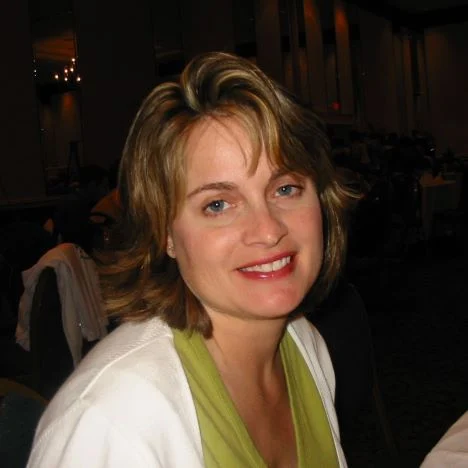
My race of choice: the 2006 Space Coast Marathon in Cocoa, Florida. We had family in the area—Lynn’s brother and her father and their families—so we turned it into a mini vacation.
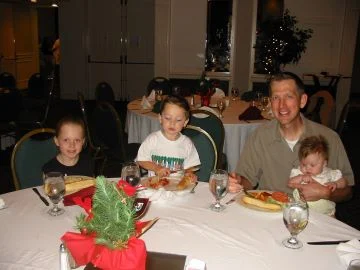
Race week coincided with Thanksgiving. I kept my diet in check to avoid GI issues, a common marathon struggle. No overeating, no excessive greasy food. We even attended the pre-race pasta dinner sponsored by the marathon committee and featuring the legendary Bart Yasso who regailed us with his experience running the Badwater ultra-marathon in 1989 which at the time was 146 miles long. Between the carb loading and the inspirtational stoires, by race day, I was ready to run my first marathon.
I didn’t sleep much the night before. Maybe four or five hours. Nerves, excitement—it was all swirling. But as I’d learn, adrenaline can override a bad night’s sleep.
Race Day: 26.2 Miles of Discovery

The marathon started early—around 6:30 AM—but Florida in November is still warm. Race-day temps climbed into the mid-70s, far from my ideal (45°F). The course followed the Indian River, an out-and-back loop done twice. Some might call that boring, but I didn’t care—it was my first marathon, and I was soaking it all in.
Everything went according to plan. My pace held steady. I alternated Gatorade and water at aid stations. I had practiced my fueling strategy in training, so I stuck with my usual gels and hydration. Nothing new on race day.
One recurring issue: my stomach. Multiple times, I thought, I should stop at that porta-potty. But by the time I reached it, I felt okay. Then, a quarter-mile later, regret. This cycle repeated three or four times. Somehow, I made it to the finish line before I had to make an emergency stop.
In the final miles, I allowed myself brief walk breaks at aid stations—10-15 seconds, just enough to drink without sloshing it all over myself. But I never hit the wall.
Crossing the Finish Line
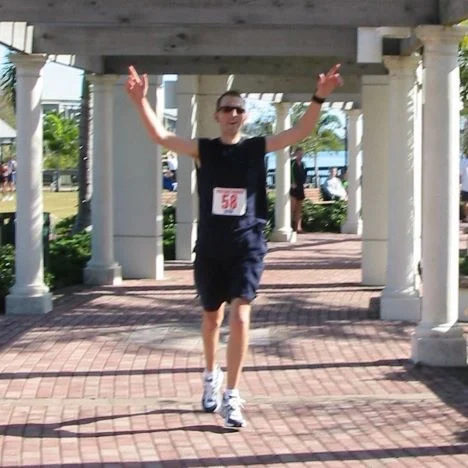
I did it!
My official time: 3 hours, 29 minutes, 25 seconds.
Pace: 7:59 per mile.

I saw my family at the finish, took my much-needed porta-potty stop, and celebrated. Back at the hotel, I spent the rest of the weekend at the pool, recovering. Lynn and the kids helped take care of me—not that the little ones knew what had just happened, but I appreciated the support.
Post-Marathon Reality: The Stairs Struggle
When we got home to Chicago, I discovered a new level of soreness. Walking downstairs was nearly impossible. My quads were shot. Even though the course was flat, by the latter miles, my form had broken down, recruiting every muscle possible to keep me moving. For days, I had to walk down the stairs backward—a rite of passage for first-time marathoners.
Final Thoughts
At 35 years old, I had officially become a marathoner.
It wasn’t easy. The training, the sacrifices, the heat, the stomach struggles—but I had done it. And I knew it wouldn’t be my last.
Looking back, I’m grateful for Lynn’s support and for my body holding up through the process. I also learned that marathon success is about more than just running miles. The right mix of training—easy miles, speedwork, and race-pace long runs—made all the difference.
And, of course, so did having a strong support system.
Stay tuned for the next chapter in my body experiment.
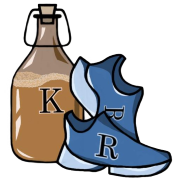
Leave a Reply
You must be logged in to post a comment.